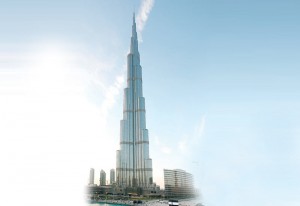By Orlando Crowcroft www.constructionweekonline.com
Solar panels on the Burj Khalifa will heat 140,000 liters of water a day, the building’s developers have claimed.
 Ahmad Al Matrooshi, the managing director of developers Emaar, said that the world’s tallest building – which re-opened to tourists on Monday – would be a benchmark for urban developments seeking sustainability in the region.
Ahmad Al Matrooshi, the managing director of developers Emaar, said that the world’s tallest building – which re-opened to tourists on Monday – would be a benchmark for urban developments seeking sustainability in the region.
“Energy efficient measures are not an option, but an imperative for sustainable growth,” Al Matrooshi said.
“By leveraging solar power Burj Khalifa is setting an example as well as creating a referral mark on how urban developments can effectively integrate energy-friendly initiatives.”
The 378 solar panels, designed by SOLE UAE systems, the oldest solar thermal company in Europe, are located on the roof of an annex to the Burj Khalifa and Emaar claim they will save a total of 3,200 kilo watts of power per day.
The Burj has also installed a system which collects moisture from the building’s air conditioning units and re-uses it to water the gardens. When operational the system will provide around 15 million gallons of water every year.
Samuel Keehn, Leed AP and environmental and sustainability manager at Energy Management Services (EMS) said that considering the Burj Khalifa’s iconic design, as well as the fact that it is largely constructed from glass, the environental initiatives were impressive.
“From a common sense, low cost no cost straightforward approach with limited impact on the client they have done a good job, ” he said.
But Keehn added that the true energy cost of the building would not be known until it was operating at full capacity.
“The building is not really operational yet and they’re not going to know how well it is performing for at least a year,” he said.
On Monday the viewing deck on the 124 story Burj had re-opened after lift problems caused a two month closure.












